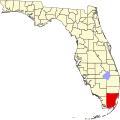Biscayne Park, Florida | |
|---|---|
| Village of Biscayne Park | |
 The historic Village Hall Log Cabin, which serves as Commission chambers for all meetings, as well as other Board meetings, and for special events. | |
 Location in Miami-Dade County and the state of Florida | |
 U.S. Census Bureau map showing village boundaries | |
| Coordinates: 25°52′18.62″N80°10′55.13″W / 25.8718389°N 80.1819806°W | |
| Country | |
| State | |
| County | Miami-Dade |
| Incorporated (town) | December 31, 1931 |
| Incorporated (village) | June 16, 1933 |
| Government | |
| • Type | Council-Manager |
| • Mayor | Jonathan E. Groth |
| • Vice Mayor | Ryan Huntington |
| • Commissioners | Veronica Amsler, MacDonald Kennedy, and Art Gonzalez |
| • Village Manager | Vacant |
| • Village Clerk | Pamela Latimore |
| Area | |
• Total | 0.64 sq mi (1.65 km2) |
| • Land | 0.62 sq mi (1.61 km2) |
| • Water | 0.02 sq mi (0.05 km2) 0% |
| Elevation | 7 ft (2 m) |
| Population | |
• Total | 3,117 |
| • Density | 5,027.42/sq mi (1,941.47/km2) |
| Time zone | UTC-5 (EST) |
| • Summer (DST) | UTC-4 (EDT) |
| ZIP Code | 33161 |
| Area codes | 305, 786, 645 |
| FIPS code | 12-06600 [3] |
| GNIS feature ID | 0278854 [4] |
| Website | www |
Biscayne Park is a village in Miami-Dade County, Florida, United States. It's also part of the Miami metropolitan area of South Florida. As of the 2020 census, the population was at 3,117 residents. [2]
